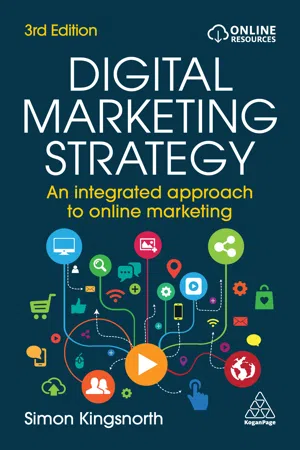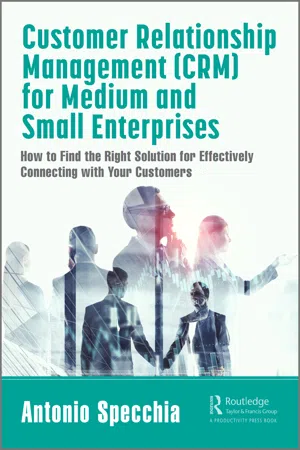Business
Methods of Good Customer Service
"Methods of Good Customer Service" refer to the strategies and practices businesses use to ensure customer satisfaction and loyalty. This includes effective communication, personalized interactions, timely resolution of issues, and a customer-centric approach. By implementing these methods, businesses can build strong relationships with their customers and enhance their reputation in the market.
Written by Perlego with AI-assistance
Related key terms
Related key terms
1 of 4
Related key terms
1 of 3
6 Key excerpts on "Methods of Good Customer Service"
- eBook - ePub
Customer Care
A Training Manual for Library Staff
- Pat Gannon-Leary, Michael McCarthy(Authors)
- 2010(Publication Date)
- Chandos Publishing(Publisher)
3What is customer service?
Treat every customer as if they sign your pay-cheque – because they do. (Anon) There are no traffic jams along the extra mile. (Roger Staubach)Aims
The aims of this chapter are as follows:to identify the ingredients of good/bad/excellent service in practice;to recognise the importance of customers’ expectations and feelings.To assist with planning, Table 3.1 presents a suggested session plan.Table 3.1 Session plan – what is customer service? *A, activity (participants); F/C, flipchart; H/O, handout; P/I, Post-it notes; T, talk (facilitator)Background
On a daily basis, we need the help and support of other people. Every contact that we make with others has elements of give and take, whether in a library, shop, restaurant, garage or wherever. When we get the response that we want, we feel good about that contact. We have experienced a positive interaction which makes us want to repeat the experience.Sometimes, we may feel that our daily contact with our customers, for example, students, members of the public, is just part of our daily routine, and is therefore somewhat humdrum and boring. On occasion, we all feel as if a robot could perform elements of our job. For customers, however, contact with us may not be routine. They have customer expectations and needs built into their feelings.In a busy working life, it is all too easy for customers to be faces in a crowd rather than individuals. However, they want to be treated as individuals, and as such, not merely processed as if they were a number. Consider encounters you have had yourself when you have been on the receiving end of customer service.There have most likely been occasions when you have gone to buy something in a shop and then walked out because you could not get assistance or because the assistants seemed more interested in talking to their colleagues than in serving you. Perhaps you went to a restaurant where the service was so slow and the serving staff so sullen that, despite the good food on offer, you decided to go elsewhere in future. How often do you order goods and services on the internet simply to avoid encountering impersonal staff in customer service situations? It is quite common to try to avoid places and people with whom you have had a negative experience, and to seek out those who make you feel good about yourself. - eBook - ePub
Digital Marketing Strategy
An Integrated Approach to Online Marketing
- Simon Kingsnorth(Author)
- 2022(Publication Date)
- Kogan Page(Publisher)
Ensuring your systems allow you to know your customer is a challenge that large businesses have always faced, as knowing each individual customer personally is impossible for most businesses when operating at scale. There are many software solutions that store all conversations and interactions in one place with features such as complaint monitoring, known issue management, knowledge base and social media integration. These features can be very powerful when used in conjunction with a customer database.Ultimately, understanding your customer is the most important stage in delivering excellent customer service.Responsiveness
One area of frustration for customers that has increased significantly in the digital age is the time taken for organizations to respond. Consumers are less patient than they used to be and have higher expectations when it comes to response. You need to be prepared to structure your business to enable fast response and therefore meet the demands of your customers.There are a number of ways that we can at least acknowledge a message straight away and be proactive in responding to our customers. A quick response with an appropriate and, where possible, personalized message can make the difference between dealing with a simple complaint quickly and it escalating into a serious issue.For example: ‘Thank you for your message Linda. Below is a copy of what you sent us for your records and we will get back to you within two hours. If you have any questions in the meantime please call us on XXX XXXX XXX.’Even if Linda is not happy with the two-hour time frame at least she knows what the time frame is and her expectations have been set. This can reduce complaints.Transparency
Another area that has continued to face increasing scrutiny in the 21st century is transparency or, put another way, openness.Transparency should always be a core principle of customer service. Consumers are more cynical than ever and a great deal of information on businesses such as turnover and management teams is available online. Regulators are also being far more aggressive in punishing organizations and releasing information when decisions are made that have a negative effect on consumers. When something goes wrong it is often quickly publicized and can even go viral. - Linda L. Lowry(Author)
- 2016(Publication Date)
- SAGE Publications, Inc(Publisher)
Customer Service in Service Businesses Customer Service in Service BusinessesSteve Burns Steve Burns Burns, StevePhil Higson Phil Higson Higson, Phil334 337Customer Service in Service Businesses
Steve Burns Phil HigsonEconomic activity in developed nations has changed significantly in recent years, shifting from predominantly manufacturing-based enterprises to the service sector. The service sector includes areas such as government, telecommunications, health care and hospitals, banking and financial services, insurance services, management consulting, retail, leisure, entertainment, hospitality, and travel and tourism. The service sector now constitutes around two-thirds of GDP in the developed countries (in Europe it is even higher, at around 70%). This means the term customer service has increasing importance, especially for the travel and tourism industry. There is no agreed-on definition of the term customer service but a reasonable starting point might be that used by the United Kingdom’s Institute of Customer Service: “the sum total of what an organisation does to meet customer expectations and produce customer satisfaction” (ICS, 2015).This denotes a broad spectrum of processes and culture, and reflects the many facets of an organization’s relationship with its customers, especially a focus on helping or assisting its customers. The term is also used to indicate elements of customer satisfaction, often qualified by such adjectives as “good,” “bad,” “excellent,” “poor.” These are used to illustrate how customers themselves perceive levels of customer service provided by the organization.We Are All Customers Now
The service revolution has changed who is perceived as a customer. In Britain, those borrowing books from libraries, students in universities, and hospital patients are all considered “customers.” Even having your rubbish collected makes you a customer, not simply someone putting out the trash. This revolution has also driven changes in the way organizations perceive their internal processes. The notion of the “internal” customer (as opposed to the “external” customer or purchaser of the organization’s goods or services) has received increasing attention. An internal customer may be anyone within the organization (which may include managers, supervisors, departmental colleagues, and staff in other departments) who contributes toward the final service or product produced by the organization. It has been argued that developing more effective internal customer relationships can lead to better external customer satisfaction, in addition to reduced costs and increased productivity.- eBook - ePub
Customer Relationship Management (CRM) for Medium and Small Enterprises
How to Find the Right Solution for Effectively Connecting with Your Customers
- Antonio Specchia(Author)
- 2022(Publication Date)
- Productivity Press(Publisher)
It’s possible to give customers what they want, but you’ll need an engagement model that allows you to move with the customer, and to shift in time with the customer’s requirements, preferences and changing expectations. You’ll also need a solution that does more for you. Solving a ticket is good, but uncovering the root problem is better. Excellent service isn’t just about resolving a ticket—it’s about getting to know your customer.A good way to get to know your customers better is to give them choices for how and when to interact with your business. It’s not just that some customers prefer the phone, while others gravitate towards self-service—it’s more that customers prefer to have options. Based on the complexity of the question, how convenient it is to find help and the context—who the customer is, what they’re doing and how urgently they need an answer—the right channel will often make itself apparent.Figure 5.2 Trends and existing situation of Customer Care contact management.The ability to offer seamless service via all channels, or to turn channels on or off strategically as you grow, allows businesses of all sizes to meet consumers’ expectations. The key is to enable your customers to have natural conversations with your business, regardless of how or when they contact you.This involves connecting all channels so that agents can have continuous conversations, with access to history and context, to give customers the effortless, fast and personalised experiences that they expect.Let Customers Say It Once, and Once Only
A hallmark of excellent service is to make it easy for a customer to contact a business and to get help. However, this is a sticking point for many businesses offering support across channels. When channels are served by different agents using different systems, customers have to explain their problem—and every step they’ve already taken to resolve the problem—to everyone they talk to.This has been the way of things for a long time, but it’s no longer the status quo. In fact, 71% of customers expect companies to collaborate internally so that they don’t have to repeat themselves. - eBook - ePub
- David Butler(Author)
- 2007(Publication Date)
- Routledge(Publisher)
Customer care is about minimizing the occurrences that are likely to give rise to complaint, and responding quickly and positively when complaints do occur. The primary objectives of customer care are to: • Retain customers for repeat business. The use of sales staff and advertising etc. to find new customers is an expensive process. If we can retain or at least reduce the rate of natural turnover of existing customers, then sales effort can be invested in finding extra new customers which overall will increase the sales revenues and profits of the business. • Increase the level of trade with existing customers by improving their confidence in the business and its products or services. Dealing with the business should constitute a pleasant and problem-free experience. This again will generate extra sales revenue and profit in the longer term. • Enhancing the reputation of the business and its quality standards. This is aimed at increasing customer loyalty and recommendation, which again adds to turnover and profit. Even customers who complain, but who are treated well in response, tend to return and to tell others about their positive experience. In contrast, poor service leads to loss of reputation and customers, and consequential reductions in turnover or the need for extra sales effort to replace lost trade • In the longer term, the implementation of customer care policies tends to reduce the costs of operations. As in the case of quality management described in the previous chapter, by building in quality systems it is possible to reduce the need for checking and inspection, leading to a reduction in the cost of quality control. Similarly, a good customer care policy tends to reduce the occurrence of problems and to correct them before they get out of hand. Customers who do not complain often go elsewhere anyway, so the idea is to avoid complaints arising in the first place, to prevent the loss of customers - Ray Donnelly(Author)
- 2010(Publication Date)
- Routledge(Publisher)
This gap refers to the differences between service delivery and the service provider’s external communication, i.e. the levels of service are not correctly communicated or understood by the customer.Gap 5
The service falls short of what the customer hoped for. Do note though, it is not always possible to remove the gaps completely.The Customer Service Programme
Having identified gaps in the level of service an organisation can take steps to address the issues. So, for example, we could try and close the gaps in the ways shown in Table 13.6Table 13.6 Ways of closing gapsGAP 1 Hold regular team meetings and management briefings to ensure they are customer focused. Research in the form of customer satisfaction surveys could be undertaken to establish customer expectations and ways to exceed or delight the customers.GAP 2 Better interaction between management and staff to establish realistic targets for staff to aspire to. GAP 3 All customer-facing staff need to be clear on what their roles are, and what targets they are expected to achieve. Clearly internal marketing has a key role to play. It is important that staff feel valued and want to work effectively.GAP 4 Service delivery standards need to be maintained and stronger targets set, but customers must be clear on what they can expect. GAP 5 Clearly, if people have an expectation of what they expect, then the organisation needs to ensure the highest levels of customer service are achieved and a customer-centric approach is adopted. Closing the gaps is, in many ways, a reactive approach. A more proactive approach is to develop a relationship marketing plan that can be based around the six markets model (discussed in earlier units) which in summary would cover:
Index pages curate the most relevant extracts from our library of academic textbooks. They’ve been created using an in-house natural language model (NLM), each adding context and meaning to key research topics.
Explore more topic indexes
Explore more topic indexes
1 of 6
Explore more topic indexes
1 of 4





